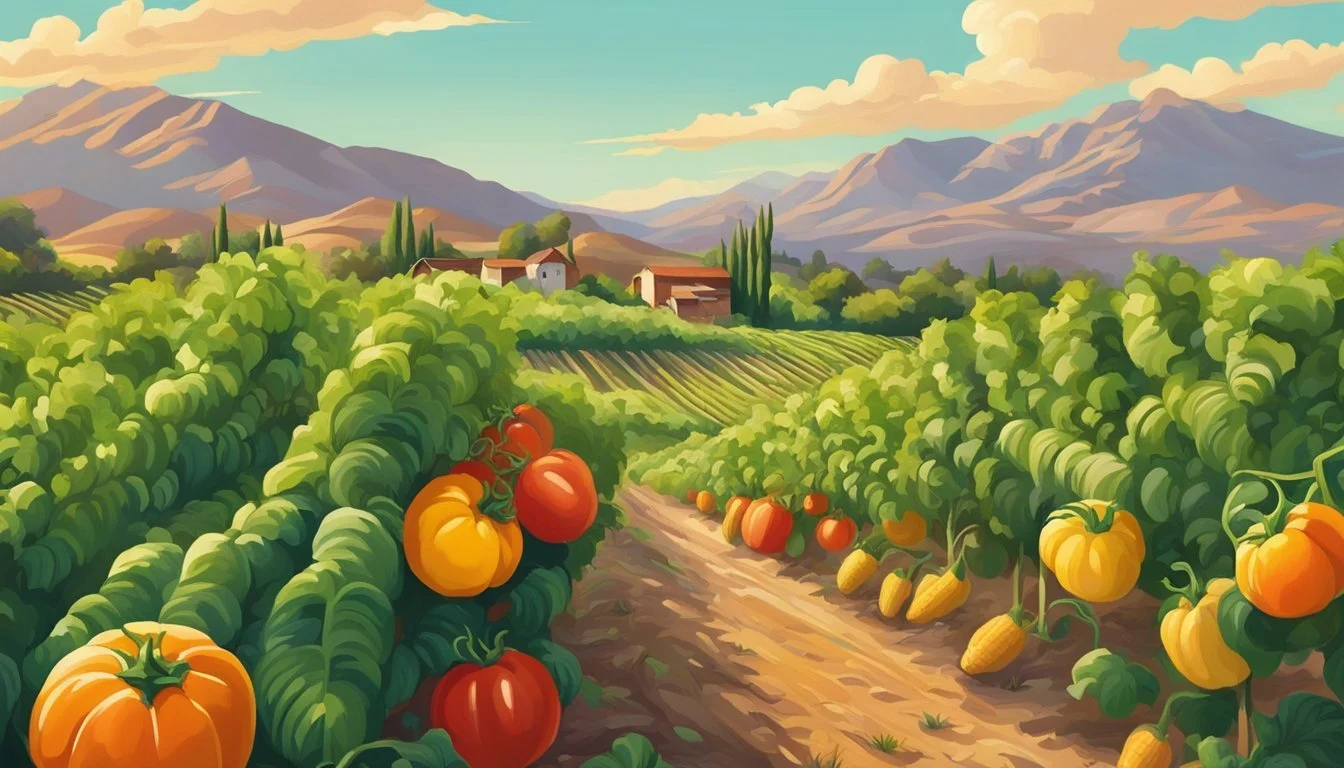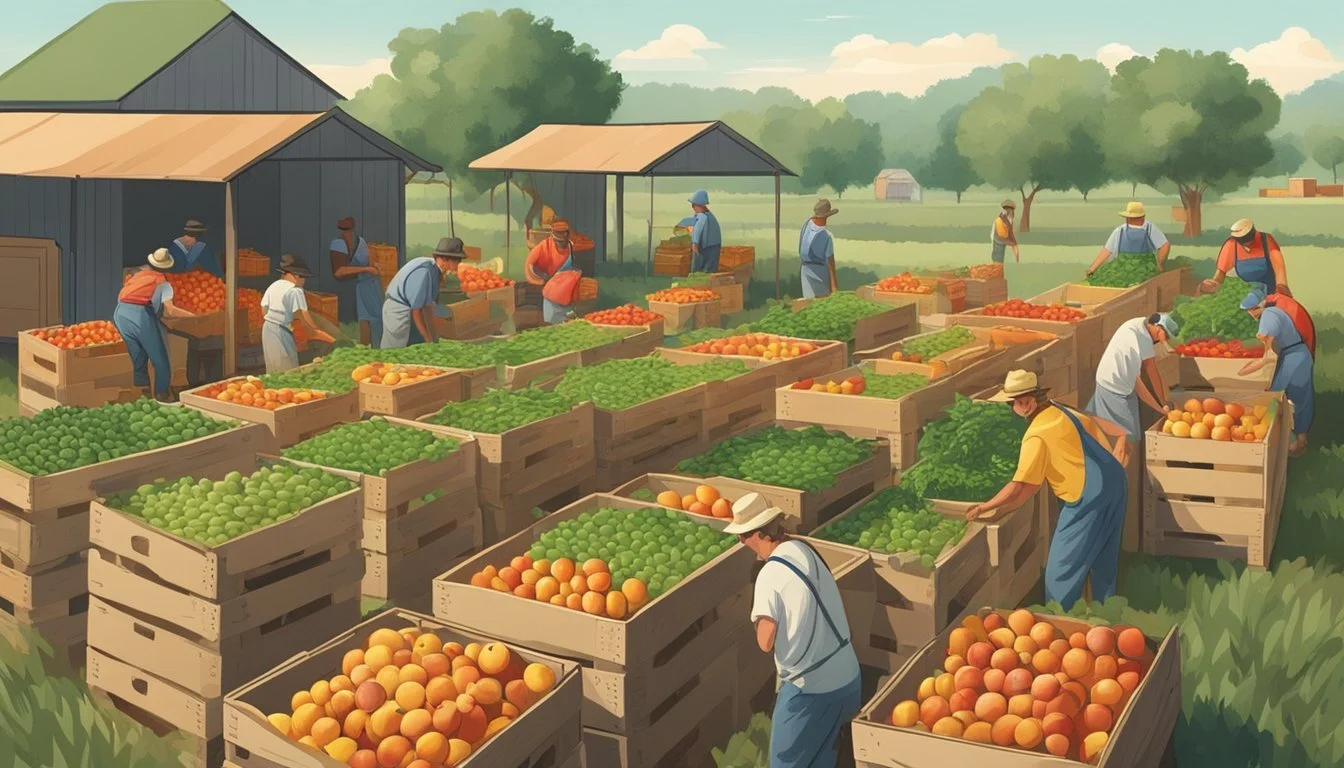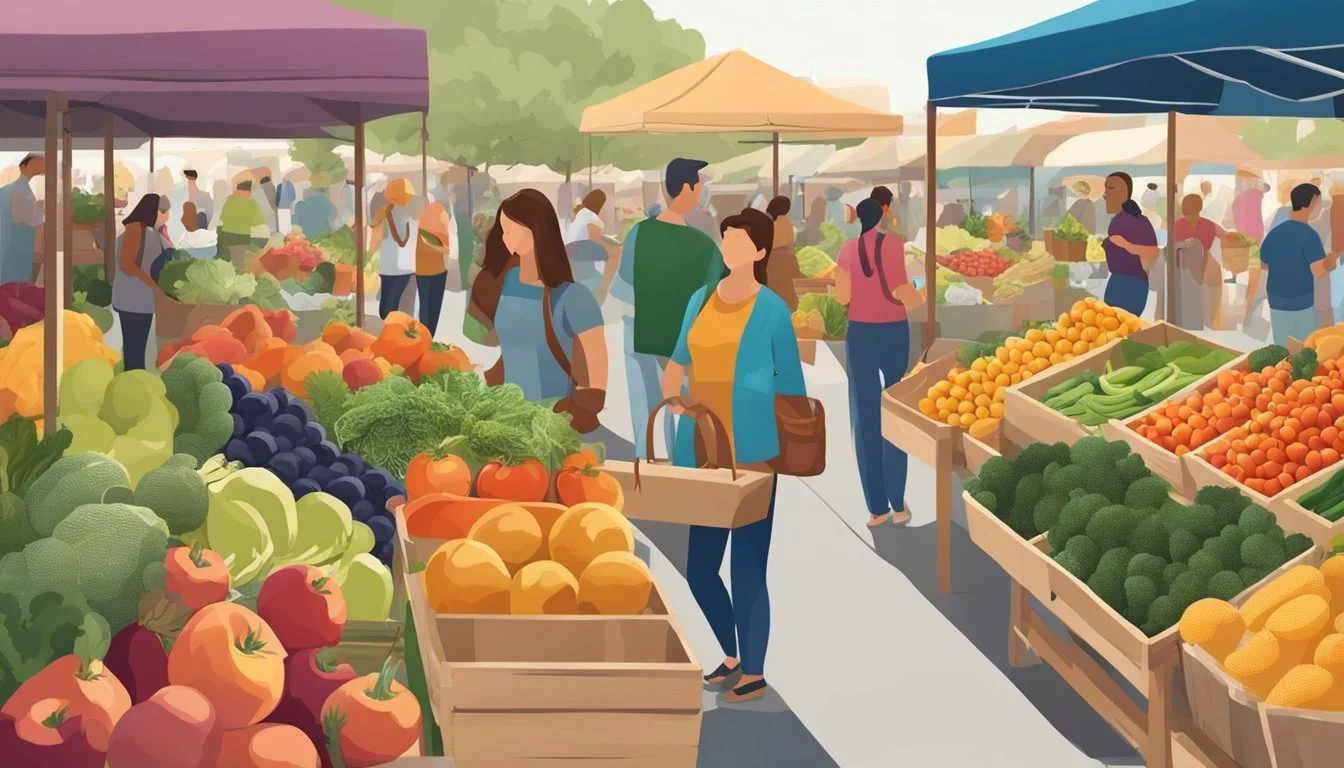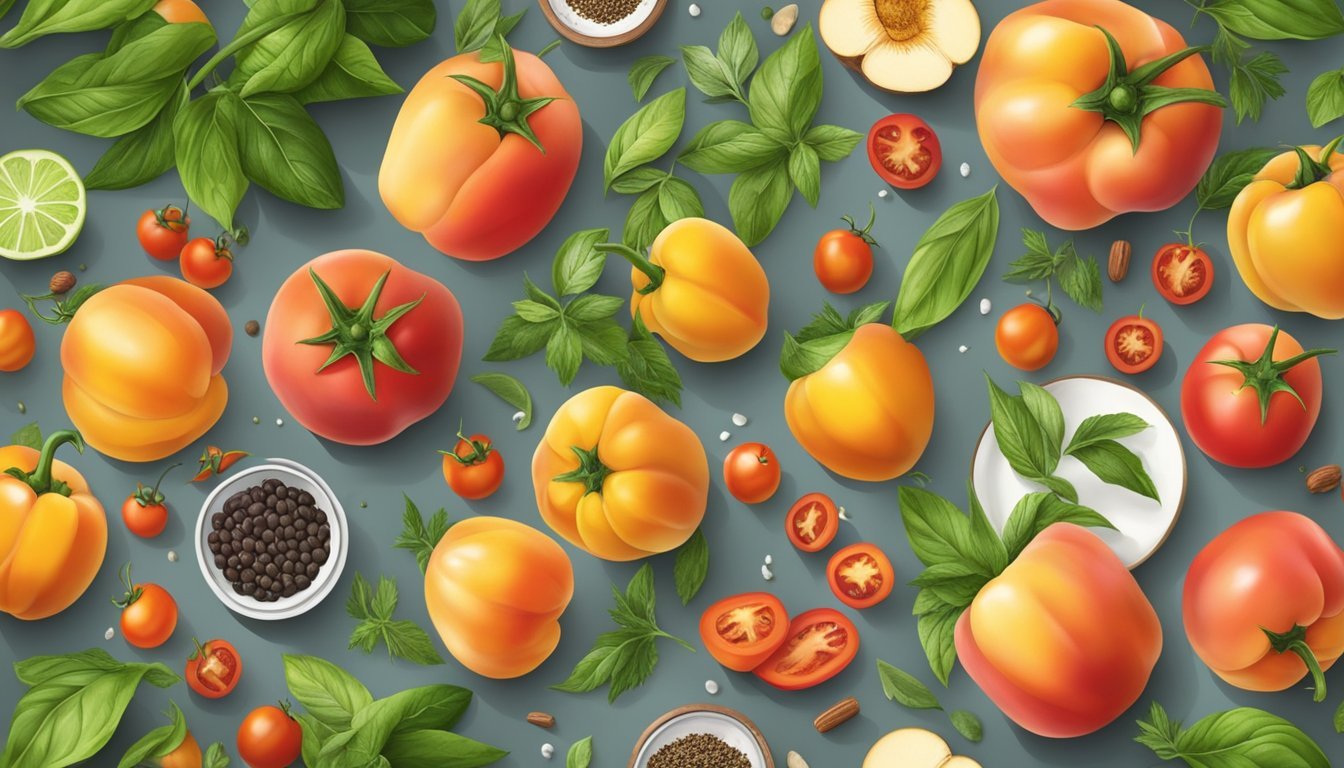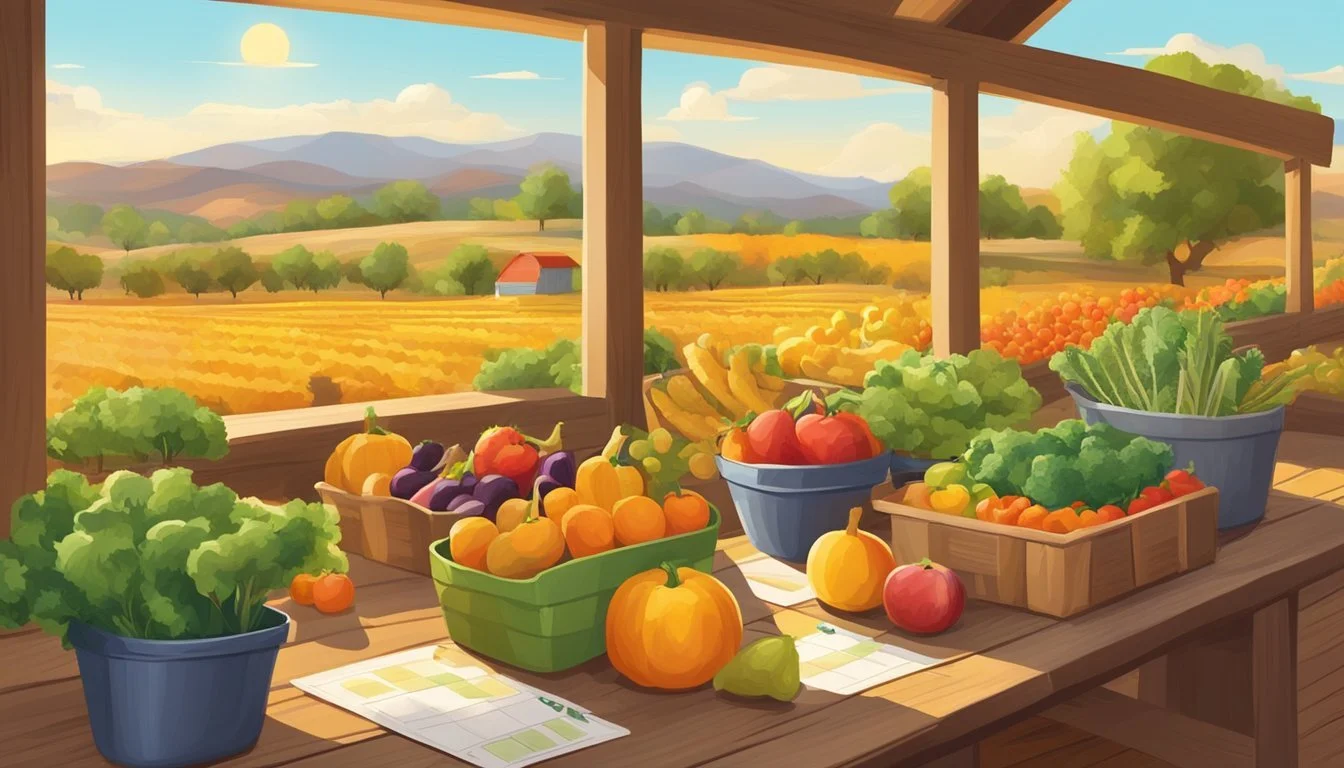Arizona Seasonal Fruit & Vegetables in September
Your Guide to Fresh Produce Shopping
This Article is Part of our Arizona Seasonal Fruit & Veg Calendar
As September ushers in the early whispers of autumn in Arizona, it remains a pivotal month for a diverse array of produce. Arizona’s unique climate, characterized by hot summers and mild winters, sets the stage for an extended growing season. September sees the convergence of late summer fruits and the beginnings of hearty fall vegetables. This transitional period is marked by the availability of an eclectic mix of produce that beckons residents and chefs alike to savor the local bounty.
The Arizona harvest in September is generous, providing a selection of leafy greens, succulent fruits, and robust vegetables. Arugula (how long does arugula last?) is still available from the summer months, while the tail end of blackberry season offers up its final, juicy harvest. Vegetables like bok choy and broccoli begin to take the spotlight, signaling a shift in seasonal culinary inspirations. This wealth of produce not only promotes seasonal eating but also supports the local farms and economies across the state.
Therein lies the charm of Arizona’s September harvest – it celebrates the intersection of seasons and the culinary versatility that comes with it. The variety of available fruits and vegetables enables a seamless transition from the light, fresh flavors of summer to the more wholesome, earthy notes of autumn. Farmers' markets and local groceries showcase everything from the remnants of summer berries to the beginnings of autumn’s root vegetables, ensuring that September’s palette is nothing short of vibrant and abundant.
Overview of Arizona’s Produce Seasons
In Arizona, September marks a transitional period where the intense heat of summer begins to give way to the milder temperatures of fall. This change signals a shift in the types of produce that are at their peak.
Seasonal Shifts from Summer to Fall
Throughout Arizona's summer months, one will find a bountiful supply of fruits and vegetables that thrive in warmer conditions. However, as September approaches, the state witnesses a gradual transition to crops more suited to the cooler fall climate. The tail end of summer offers the final yields for heat-loving crops, while early fall varieties start to make their appearance.
Late Summer Harvest:
Fruits: Blackberries (how long do blackberries last?), Melons
Vegetables: Corn, Tomatoes
Emerging Fall Harvest:
Fruits: Apples (how long do apples last?), Pears
Vegetables: Root vegetables like Carrots and Beets (how long do beets last?)
September Climatic Influence on Crops
September's climate in Arizona exerts significant influence over agricultural yield. Crops that are sensitive to the extreme heat of the Arizona summer find reprieve in September's cooler evenings and gradually declining daytime temperatures. This climatic shift allows certain crops to flourish, offering farmers the chance to harvest a diverse array of produce.
Climate-Responsive Harvest:
Cooler nights enhance the sweetness of fruits like Apples.
Warm, but milder days allow for extended growing seasons for various Greens.
In essence, Arizona's September climate fosters the growth of a unique blend of produce, with the last of the summer fruits and vegetables sharing the fields with the first robust crops of fall.
Fruits in Season
In September, Arizona offers a robust selection of ripe fruits, from the succulent citrus varieties to the sweet stone fruits and melons. The mild weather at this time of year provides an ideal transition for the harvest of these fruits.
Citrus Wealth of Arizona
Arizona is not yet in full citrus season in September, but one can anticipate the beginning stages of the citrus harvest, as groves start to burgeon with early varieties. Grapefruits and lemons are among the first to signal the upcoming citrus abundance. Although the peak for citrus fruits is later in the year, these early fruits set the stage for what's to come.
Berry Varieties and Harvest Times
Berries have a short and sweet presence in Arizona's September. The tail end of the blackberry season offers the last chance for these juicy gems. As for grapes, although not berries in the botanical sense, vineyards are abuzz with activity, as this month sees a variety of grapes reach perfect ripeness. The grape harvest is an event celebrated by local wineries and fresh market enthusiasts alike.
Stone Fruits and Melons
This month is the final call for some of Arizona's stone fruits. Plums and late-harvest peaches are still available, offering a final taste of summer sweetness. Additionally, melons are at their best, with various types including cantaloupe (how long does cantaloupe last?) and honeydew being bountiful and at peak flavor. Figs and dates also make a noteworthy appearance, with their distinct textures and rich tastes conveniently coinciding with the start of fall.
Vegetables Peaking in September
As September arrives in Arizona, it brings a bounty of vegetables reaching their peak ripeness. This month is particularly rich for harvesting a variety of root vegetables, an assortment of squash, and an abundance of leafy greens, providing a perfect opportunity for garden-fresh meals.
Crucial Root Vegetables
Root vegetables are a cornerstone of the September harvest. They are known for their storage life and hearty flavors, making them staples in many kitchens.
Beets: These are versatile and can be enjoyed raw in salads, roasted, or pickled for a tangy treat.
Carrots: Known for their sweetness which intensifies when roasted.
Radishes: Provide a peppery punch to salads and make for a crunchy, fresh snack.
Sweet Potatoes: A sweeter root option, ideal for baking or creating comforting dishes.
Potatoes: Essential for a variety of dishes, from mashed to roasted, they're a must-have in any pantry.
Squash and Gourds
Squash becomes a highlight in September, with many varieties available. They are perfect for hearty meals and pair well with a range of spices and herbs.
Pumpkins: Beyond decorating, they offer a rich flesh suitable for pies, soups, and roasted dishes (What wine goes well with roasted dishes?).
Squash: This broad category includes varieties such as zucchini, which are still in supply, and the hardier winter squash which begin to come into season.
Leafy Greens and Salad Essentials
Leafy greens thrive in the cooler weather that September can bring, and they form the basis of nutritious and vibrant salads.
Lettuce: A variety of lettuces are harvested, providing a base for many types of salads.
Spinach: Rich in iron and perfect for both fresh salads and cooked dishes.
Greens: This category covers a range of vegetables from arugula to kale, all known for their nutritional value and flavor.
Through careful selection, these vegetables can form the core of countless recipes that capture the essence of Arizona's September harvest.
Herbs and Other Aromatic Produces
September in Arizona marks a time when gardeners and cooks can enjoy an array of aromatic herbs, notable for their contributions to culinary dishes and garden aesthetics. Two particularly resilient and flavorful herbs stand out during this season: basil and garlic.
Basil thrives in the warmer months, and in Arizona, September still provides enough warmth for basil to flourish. Gardeners may find various types of basil readily available, including Sweet, Genovese, Thai, and Purple varieties. Each of these brings its own unique flavor profile to dishes, with Sweet Basil being commonly used in Italian cuisine and Thai Basil in Asian dishes.
Sweet Basil - Ideal for pesto and tomato-based recipes.
Genovese Basil - A classic choice for authentic pesto.
Thai Basil - Has a licorice-like taste suitable for Thai cooking.
Purple Basil - Offers a colorful twist with a slightly spicier flavor.
Garlic, on the other hand, is on the verge of being ready for harvest after its October planting. In Arizona, the soft-neck varieties are favored due to their suitability for warmer climates. Pre-chilling the cloves before planting can enhance the growth and yield of the crop. The garlic planted in the previous year would typically be harvested in late May, but September is an ideal time for chefs to utilize the stored bulbs.
Garlic - A foundational ingredient used in a variety of cuisines for its pungent flavor and aromatic quality.
When considering herbs for September plantings or culinary use in Arizona, gardeners and cooks should prioritize locally available varieties with proven performance in the warm, arid climate. These aromatic produce not only add flavor to meals but also contribute to the diversity and beauty of gardens across the region.
Harvesting Techniques and Storage Tips
When it comes to enjoying Arizona's seasonal bounty in September, knowing how to properly harvest and store fruits and vegetables is crucial. These techniques ensure maximum freshness and longevity, allowing one to savor the sweet and raw flavors that September's harvest has to offer.
Proper Picking Practices
In September, one should select fruits and vegetables when they're ripe and full of natural sweetness, as this is when their flavor is at its peak. For example:
Apples: Pick when the color is fully developed and the fruit separates easily from the branch.
Blackberries: Look for deep, even color and plumpness; they should pull free from the plant with a gentle tug.
Using the proper technique to harvest these crops ensures they remain intact and unbruised, preserving their quality.
Storing for Freshness and Longevity
After harvesting, proper storage is key to maintaining the fresh taste and nutritional value of produce. Here are some tailored tips:
Fridge:
Apples: Store in a plastic bag in the crisper drawer to maintain moisture.
Blackberries: Keep in a single layer, preferably in a container, to avoid crushing; refrigerate.
Dry and Cool Storage:
Root Vegetables: Place in a cool, dark place with good ventilation. For beets, this means a cellar or a ventilated box layered with dry sand.
Herbs: Hang in bunches or lay flat on screens in a dry area with good air circulation until they crisp.
Remember, excess water can increase the chance of mold growth, so fruits and vegetables should be dry before refrigerating.
Arizona’s Local Farming and Markets
Arizona's agricultural scene thrives through a robust network of local farming initiatives and markets. These ventures provide an array of fresh, seasonal produce directly to consumers and are vital to the state's economy and community health, particularly in regions such as Phoenix.
Community Supported Agriculture (CSA)
Community Supported Agriculture programs in Arizona offer a tangible way for consumers to buy seasonal food directly from local farmers. By purchasing shares or memberships, individuals receive a regular supply of fresh produce. Phoenix, for example, has numerous CSA options, connecting residents with a variety of fruits and vegetables harvested at their peak in September.
Typical CSA Box in September Might Include:
Arugula
Basil
Beets
Black-Eyed Peas (how long do black-eyed peas last?)
Farmers Markets and Economies
Farmers markets play a critical role in Arizona's local economies, especially within urban areas like Phoenix. They not only act as outlets for fresh, seasonal produce but also foster direct relationships between producers and consumers. In September, these markets are vibrant with the harvests of late summer and early fall, offering an abundance of fruits and vegetables.
Common Finds at Farmers Markets in September:
Blackberries
Blueberries
Broccoli
Bok Choy
By supporting these local markets and CSA programs, consumers help sustain Arizona's agricultural heritage and contribute to the local economy.
Health Benefits of Seasonal Eating
Seasonal eating supports not only one's personal health but also the environment and local economies. Embracing the fruits and vegetables of the season can lead to better nutrition and a more sustainable lifestyle.
Nutritional Advantages
Seasonal produce often contains higher levels of nutrients compared to fruits and vegetables that are not in season. For example, during the fall, pumpkins, which are rich in vitamins, reach their peak nutritional value and provide a sweet and golden taste along with health benefits. Similarly, arugula and broccoli, which are most commonly harvested from October to March in Arizona, offer crisp textures and full flavors in addition to a host of vitamins and minerals when consumed raw or cooked.
Vitamin content: In-season produce typically offers more vitamins.
Flavor profile: Seasonal fruits and veggies often taste better, making them more enjoyable to eat.
Environmental and Economic Perks
By choosing to eat seasonally, consumers are also indirectly supporting sustainable farming practices. This, in turn, results in a reduced carbon footprint as the transportation of out-of-season produce from distant locations is minimized. Economically, when one purchases from local farmers during their peak seasons, it supports the local agriculture sector and often results in cost savings, reflecting the abundance of the produce.
Reduced transportation: Lesser need to import produce from far away.
Support for local farmers: Direct economic support to the community's agriculture.
Eating seasonally is not just about enjoying a crisp apple in the fall or a sweet melon in the summer; it's also about making choices that positively impact one's health, the environment, and the local economy.
Recipes and Preparation Ideas
September in Arizona brings a cornucopia of fresh produce ideal for creating colorful dishes. This time of year, Arizona’s bounty offers a variety of fruits and vegetables suitable for a range of culinary preparations, from simple salads to preserved treats.
Simple Salads
Utilizing the raw freshness of September's harvest, one can prepare simple yet delightful salads. Combining thinly sliced beets and carrots with a citrus vinaigrette can showcase the vibrant flavors of the season. Tomatillos, though often cooked, make a zesty addition to salads when chopped and mixed with peppers and a hint of lime.
Tomatillo Salad:
Diced tomatillos, sliced red peppers, red onion
Dressing: Lime juice, olive oil, salt, and pepper
Hearty Roasts
Roasted vegetables are a comfort as the evenings begin to cool. Squash and potatoes, when roasted, develop a sweet, caramelized exterior that pairs beautifully with herbs and a sprinkling of sea salt (how long does sea salt last?). A medley of cubed squash, potatoes, and whole carrots tossed in olive oil and rosemary can be roasted until fork-tender.
Autumn Roast:
1-inch cubed squash and potatoes, whole baby carrots
Season: Rosemary, thyme, olive oil, salt, and pepper
Roast at 400°F until golden and tender
Homemade Preserves
To extend the taste of September throughout the year, one might consider making preserves. Applesauce is a classic preparation where apples are cooked down with a touch of cinnamon. Similarly, tomatillos can be turned into a tangy salsa verde that is perfect for canning.
Cinnamon Applesauce:
Apples, water, cinnamon, sugar to taste
Cook until apples are soft; blend for a smooth texture
Tomatillo Salsa Verde:
Roasted tomatillos, onion, peppers, garlic, cilantro
Blend and simmer before canning
Seasonality Calendar and Checklists
The section provides a concise guide to navigating Arizona's seasonal produce availability specifically in September, along with practical shopping lists for consumer planning.
Monthly Seasonal Guides
September marks the transition from summer to fall, and in Arizona, this month offers a unique blend of produce that is ripe for harvest. Fruit enthusiasts can enjoy the final servings of blackberries in early September, while apples like the Gala variety become abundant. Vegetable-wise, it's the optimal time for green leafy arugula, which has been available since the previous fall, and various types of squash begin to peak.
Notable Produce for Neighboring Months:
August sees the tail end of basil and peak season for summer vegetables.
October introduces a greater variety of squash and the early arrival of broccoli.
November is favorable for root vegetables like beets, with their season extending through to spring.
July, while not directly adjacent to September, marks the beginning of the period for black-eyed peas that lasts until September.
Shopping Lists
When constructing a shopping list for September in Arizona, consumers can focus on incorporating a variety of fresh and local produce. Below are some key items that are typically available:
Fruits:
Apples (Gala and others)
Blackberries (early September)
Vegetables:
Arugula
Summer Squash
Various Squash (as we move into October)
By considering this seasonal information, consumers can make informed decisions that support local farmers and enjoy produce at its peak of freshness and flavor.
Conclusion
In Arizona, the month of September is a transitional period where the summer heat begins to dissipate, paving the way for an array of fresh produce. Consumers can indulge in the last summer offerings while welcoming the beginnings of fall's bounty. The market brims with a fusion of flavors, from the last sweet berries to the first of autumn's robust vegetables.
Fruits Available:
Blackberries: Reach the end of their season, offering a final chance for summer sweetness.
Blueberries: Still available in early September, providing a burst of antioxidants.
Vegetables in Harvest:
Arugula: This peppery leafy green continues to flourish.
Beets: Root vegetables that begin their peak season, ready for a variety of dishes.
Broccoli: A staple that transitions well into the cooler months, starts its season.
September in Arizona also signals the ideal time for farmers to start preparing the soil for upcoming fall plantings. Home gardeners and local producers alike perform their final harvests of summer favorites and ready their fields for the next crop rotation.
The diversity of Arizona's climate yields a multitude of produce, ensuring that farmers' markets remain stocked with fresh, local options. The produce available in September underlines the region's rich agricultural tapestry and provides consumers with a plethora of vibrant and nutritious choices.


